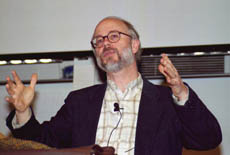- Title Page
- Introduction
- York's Newspapers
- The School Board
- A new theory
- Darwin's theory
- A legal history of evolution
- Intelligent Design
- When science meets politics
- September story
- The statement and the lawsuit
- Covering the controversy
- Holes in evolutionary theory?
- Spotlight on Dover
- The trial: The plaintiffs' case
- The trial: The defense
The trial: The defense
Since Lebo was reporting on the day-to-day events of the trial, and the first week was devoted to the plaintiffs’ case, the question of balance never arose. Neither Lebo nor her editors felt that she needed to temper arguments favoring evolution with arguments favoring intelligent design. Those would come later.

An image of bacterial flagellum.
Courtesy National Science Foundation
On Tuesday, October 18, Lehigh University microbiologist Michael Behe, one of the founding intellectual fathers of the intelligent design movement, took the stand for the defense. He explained that intelligent design proponents inferred design from the “purposeful arrangement of parts” in biology; that living things and their parts seemed to have been planned with intent. As an example, he cited the bacterial flagellum, whose tail rotates by means of a motor-like structure at its base. Behe argued that this motor required 30 to 40 protein parts to function, and that the removal of any one of them would render the structure useless—in particular, none of the proteins on their own conferred survival advantages that favored their reproduction. Thus, a series of incremental steps as proposed by Darwin could not explain the structure, which must have appeared fully formed.

Michael Behe.
Courtesy The Maine Campus Online
Behe had written a book about intelligent design, Darwin’s Black Box , in which he argued that “intelligent design theory focuses exclusively on proposed mechanisms of how complex biological structures arose.” Referring to this claim, plaintiffs’ attorney Eric Rothschild asked Behe under cross-examination: “Please describe the mechanism that intelligent design proposes for how complex biological structures arose.”
Lebo watched as Rothschild repeated the question several times and Behe, in Lebo’s estimation, used the kind of vague and confusing language she remembered from her earlier reporting on intelligent design. Lebo thought he was dodging a question about which she too had long been curious. Biologists had explained to her satisfaction how evolution worked—through natural selection. But how did intelligent design work? Behe finally replied to Rothschild:
[Intelligent design] does not propose a mechanism in the sense of a step-by-step description of how those structures arose. But it can infer that in the mechanism, in the process by which these structures arose, an intelligent cause was involved. [1]
Lebo thought this moment represented another significant victory for the plaintiffs, and that the defense’s case was so far unimpressive. She returned to the Daily Record ’s offices that evening to write her story on the day’s events. She began with what she felt was the most important event of the day:
One of intelligent design's leading experts could not identify the driving force behind the concept. In his writings supporting intelligent design, Michael Behe, a Lehigh University biochemistry professor and author of “Darwin's Black Box,” said that “intelligent design theory focuses exclusively on proposed mechanisms of how complex biological structures arose.” But during cross examination Tuesday, when plaintiffs’ attorney Eric Rothschild asked Behe to identify those mechanisms, he couldn’t. [2]
Lebo knew her editors had not been entirely happy with her coverage of the trial so far. She suspected that she had enjoyed relative editorial freedom because the first half focused on the plaintiffs. Now that the defense—that is, the pro-intelligent design side—was presenting its case, editors probably expected her to present that side the same way she had presented the plaintiffs’—with a heavy focus on the strengths of their case. But, as she recalled later, she felt that plaintiffs’ attorney Rothschild had “eviscerated” the defense in cross-examination. [3] She did not want to impose a false sense of balance on her article; at the same time, she wanted to be fair to the legal process in which both sides did get an equal chance to present their views. Did she owe the defense the same benefit of the doubt that the judge in the case did? Should she approach her court reporting differently from her science reporting?